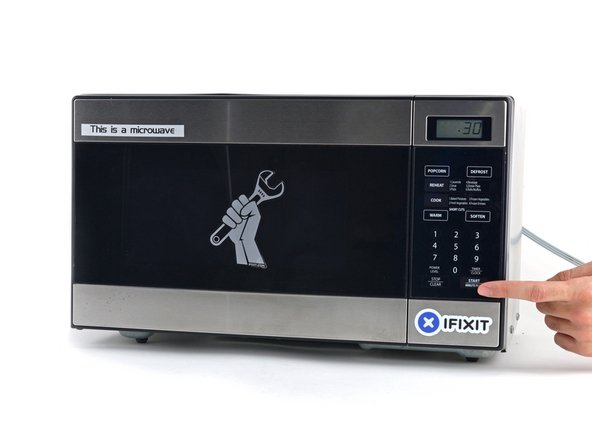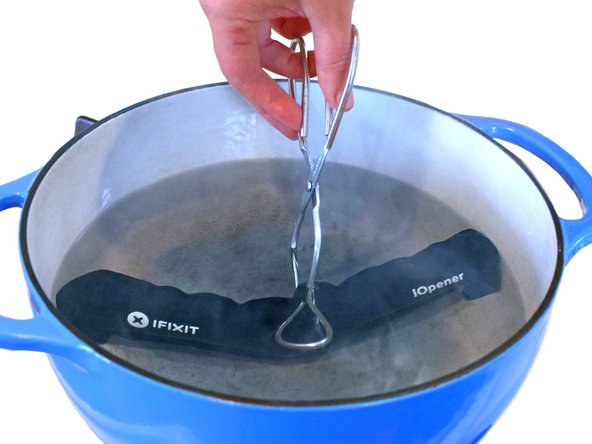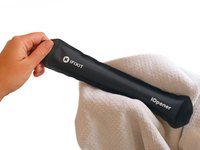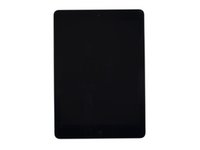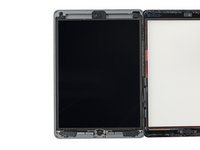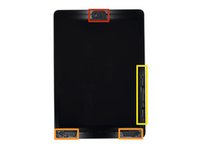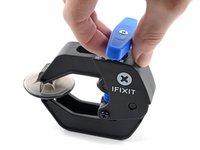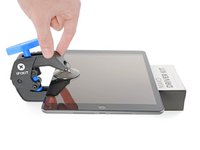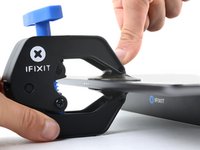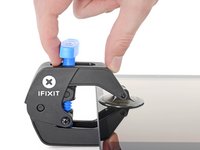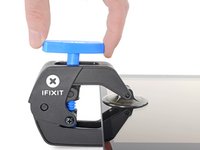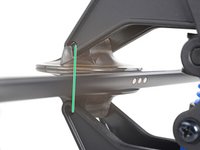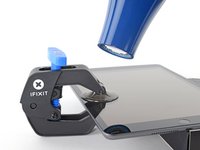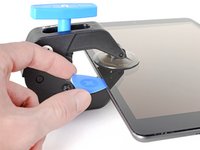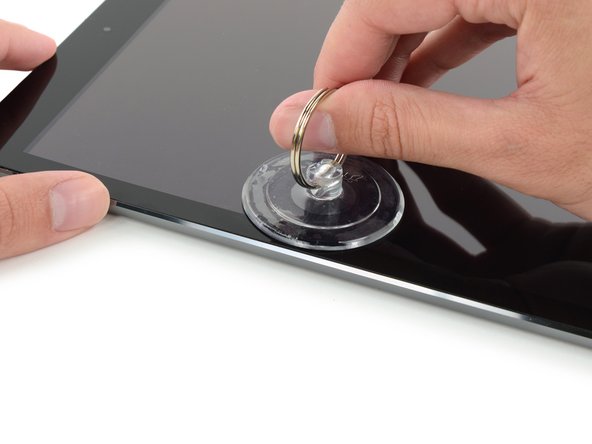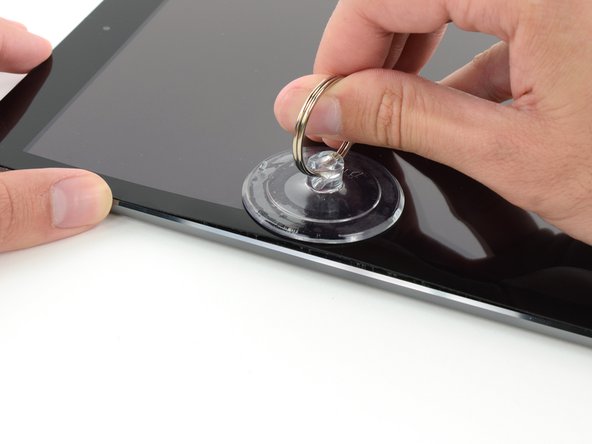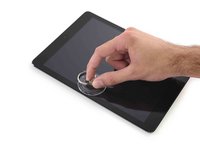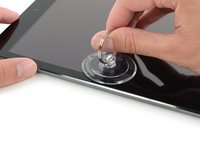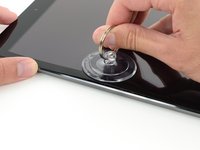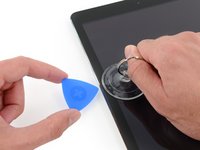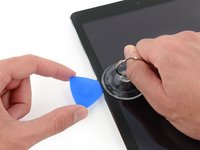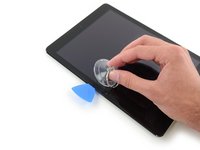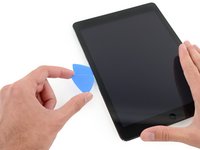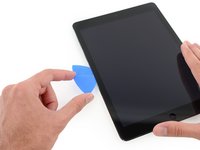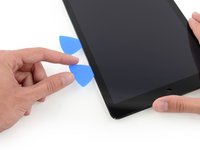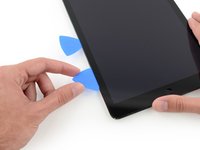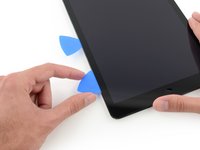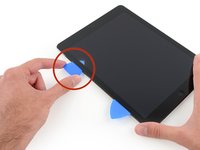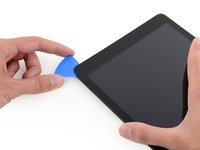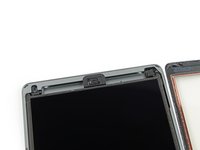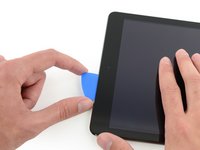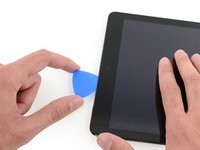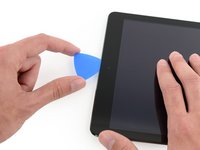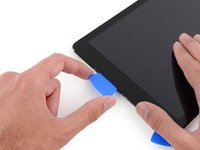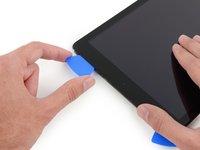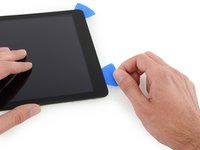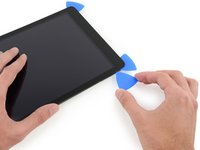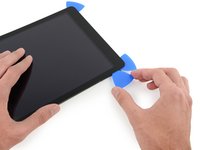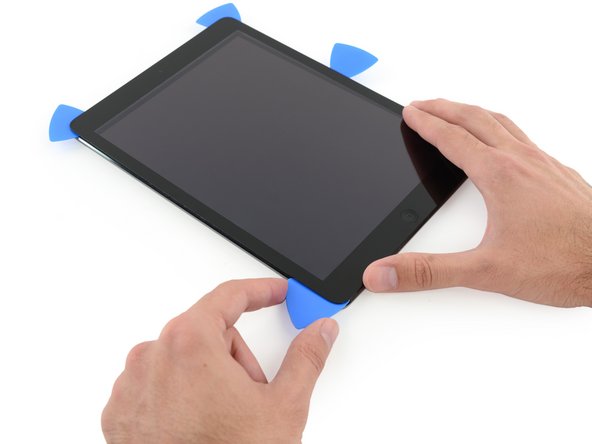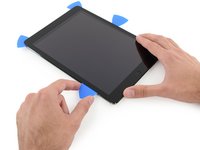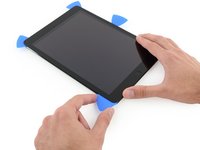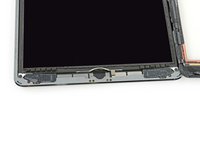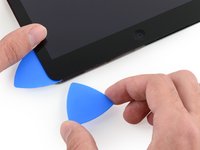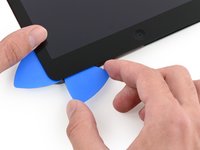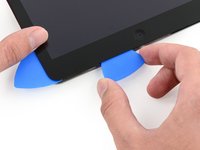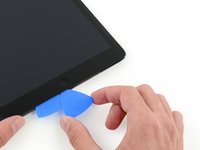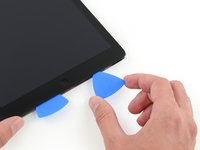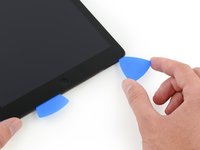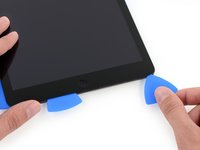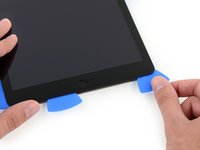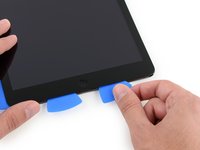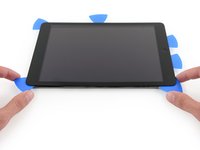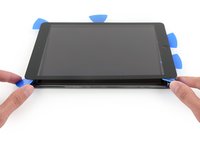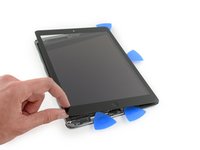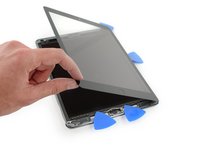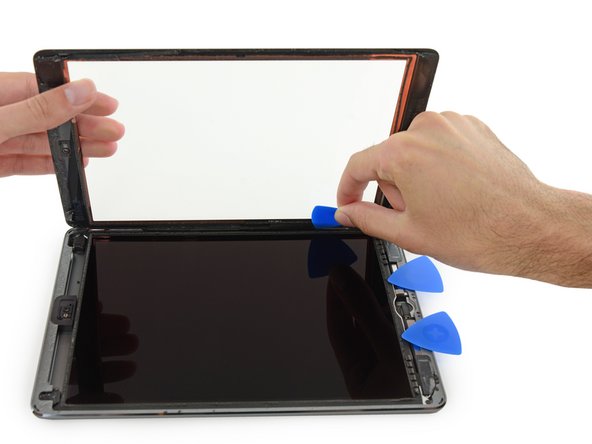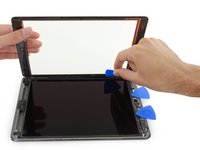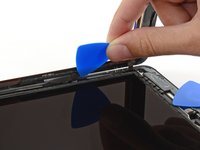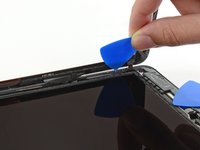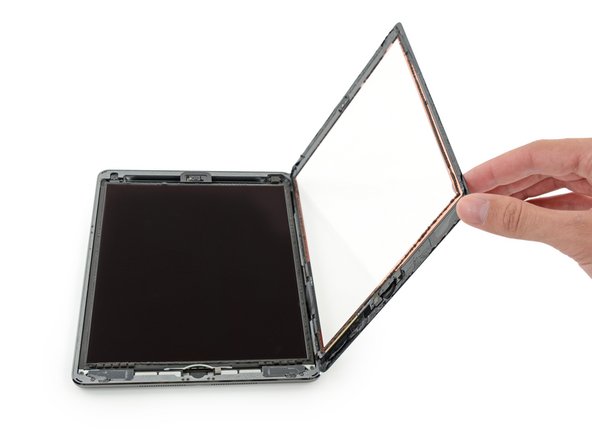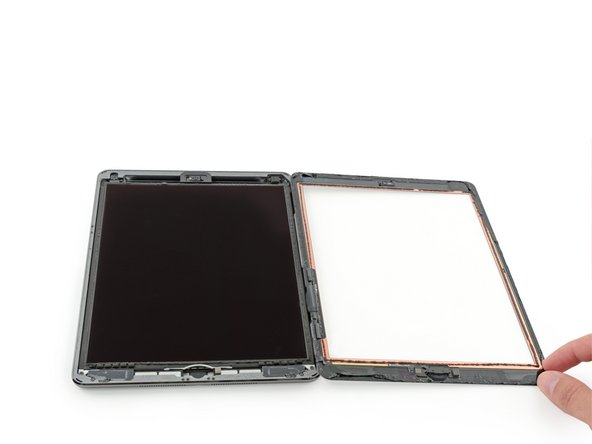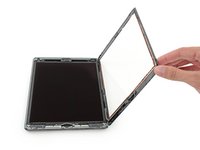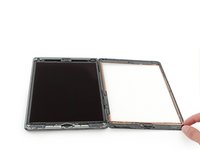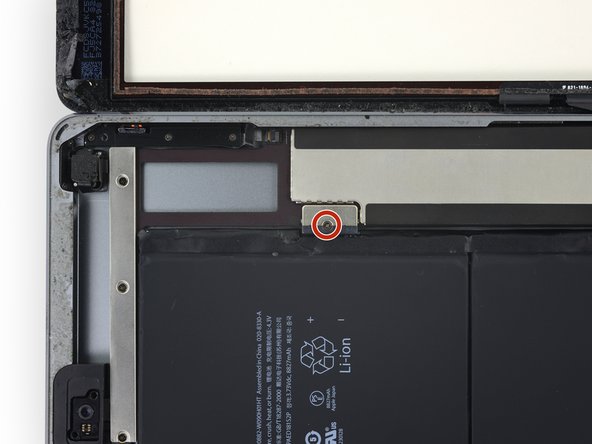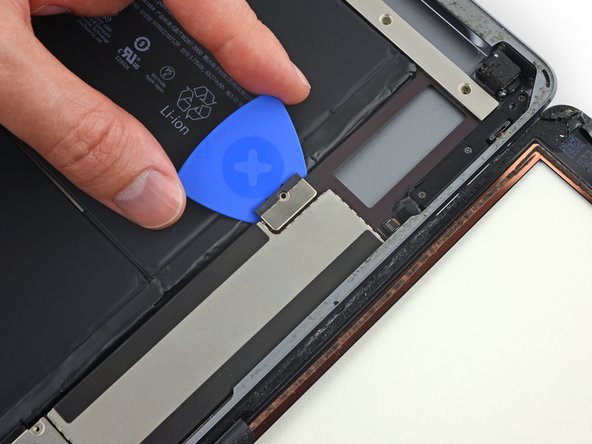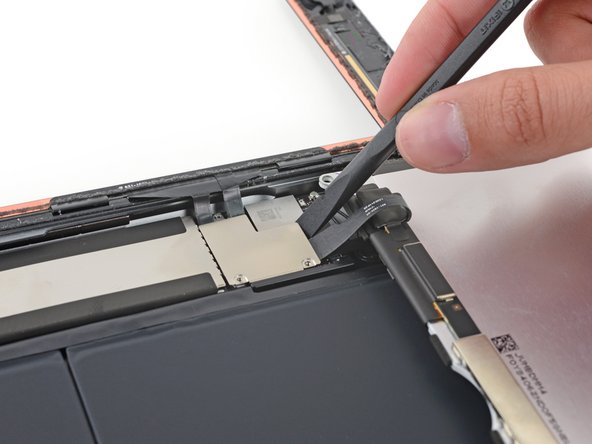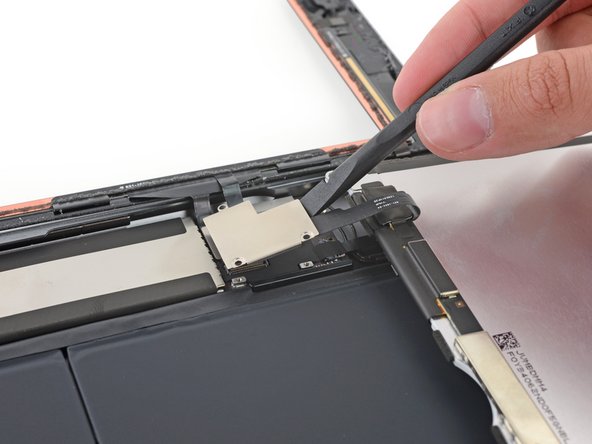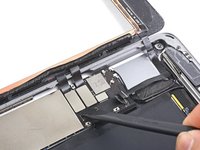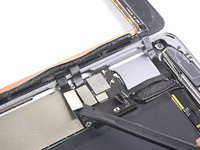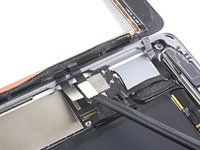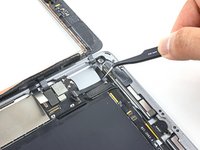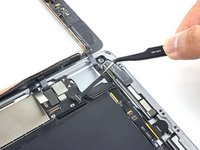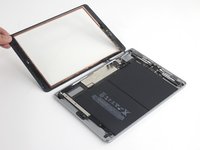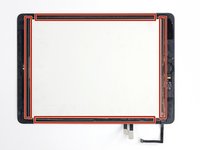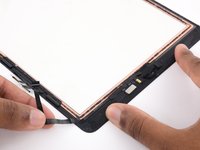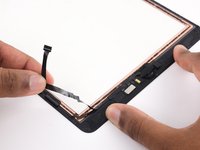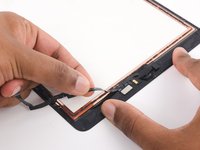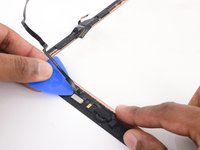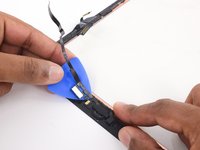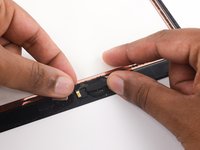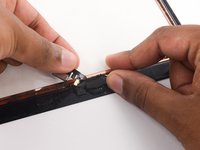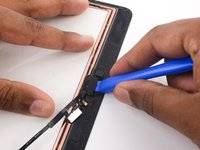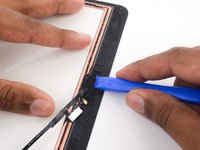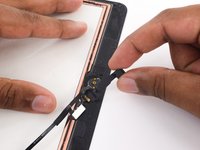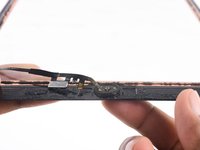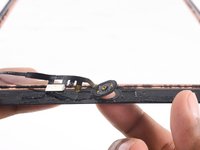Introdução
Follow the steps in this guide to replace the home button assembly in an iPad 6 Wi-Fi.
Note that the Touch ID sensor in the home button is paired to its respective logic board, so replacing the home button will result in loss of Touch ID functionality.
Be very careful when you isolate the battery using a battery blocker. The battery contacts are easily damaged, resulting in irreversible damage. If you choose to complete the guide without isolating the battery, avoid using metal tools except when completely necessary (like when removing screws) to prevent shorting the battery and damaging sensitive circuit components.
O que você precisa
-
-
Heat an iOpener and apply it to the left edge of the device for two minutes.
-
-
-
While you're waiting for the adhesive to loosen, note the following areas that are sensitive to prying:
-
Front camera
-
Antennas
-
Display cables
-
-
Ferramenta utilizada neste passo:Clampy - Anti-Clamp$24.95
-
Pull the blue handle backwards to unlock the Anti-Clamp's arms.
-
Place an object under your iPad so it rests level between the suction cups.
-
Position the suction cups near the middle of the left edge—one on the top, and one on the bottom.
-
Hold the bottom of the Anti-Clamp steady and firmly press down on the top cup to apply suction.
-
-
-
Wait one minute to give the adhesive a chance to release and present an opening gap.
-
If your screen isn't getting hot enough, you can use a hair dryer to heat along the left edge of the iPad.
-
Insert an opening pick under the digitizer when the Anti-Clamp creates a large enough gap.
-
Skip the next step.
-
-
-
Once the screen is warm to touch, apply a suction handle to the left edge of the screen and as close to the edge as possible.
-
Lift the screen with the suction handle to create a small gap between the digitizer and the frame.
-
Insert an opening pick into the gap between the digitizer and the frame.
-
-
-
Insert a second opening pick into the gap you just created.
-
Slide the pick toward the bottom-left corner of the device to separate the adhesive.
-
Leave the pick in the bottom-left corner to prevent the adhesive from re-sealing.
-
-
-
Heat an iOpener and apply it to the top edge of the device for two minutes.
-
-
-
Rotate the pick around the top-left corner of the device to separate the adhesive.
-
-
-
Slide the opening pick along the top edge of the device, stopping just before you reach the front camera.
-
-
-
Heat an iOpener and apply it to the right edge of the device for two minutes.
-
-
-
Rotate the pick around the top-right corner of the device to separate the adhesive.
-
-
-
Insert a new opening pick and slide it to the middle of the iPad's right edge.
-
-
-
Heat an iOpener and apply it to the bottom edge of the device for two minutes.
-
-
-
Slide the bottom-left pick to the bottom-left corner to separate the adhesive.
-
Leave the pick in the bottom-left corner before moving to the next step.
-
-
-
Insert a new opening pick into the gap you just created on the bottom edge of the iPad.
-
Slide the pick over the antenna, stopping just before the home button.
-
Leave the pick to the left of the home button before continuing.
-
-
-
Heat an iOpener and apply it to the right edge of the device for two minutes.
-
-
-
While supporting the digitizer, slide an opening pick between the two display cables to separate the last of the adhesive.
-
-
-
-
Fill a pot or pan with enough water to fully submerge an iOpener.
-
Heat the water to a boil. Turn off the heat.
-
Place an iOpener into the hot water for 2-3 minutes. Make sure the iOpener is fully submerged in the water.
-
Use tongs to extract the heated iOpener from the hot water.
-
Thoroughly dry the iOpener with a towel.
-
Your iOpener is ready for use! If you need to reheat the iOpener, heat the water to a boil, turn off the heat, and place the iOpener in the water for 2-3 minutes.
-
-
-
If your display glass is cracked, keep further breakage contained and prevent bodily harm during your repair by taping the glass.
-
Lay overlapping strips of clear packing tape over the iPad's display until the whole face is covered.
-
Do your best to follow the rest of the guide as described. However, once the glass is broken, it will likely continue to crack as you work, and you may need to use a metal prying tool to scoop the glass out.
-
-
Ferramenta utilizada neste passo:Clampy - Anti-Clamp$24.95
-
Pull the blue handle backwards to unlock the Anti-Clamp's arms.
-
Place an object under your iPad so it rests level between the suction cups.
-
Position the suction cups near the middle of the left edge—one on the top, and one on the bottom.
-
Hold the bottom of the Anti-Clamp steady and firmly press down on the top cup to apply suction.
-
-
-
Wait one minute to give the adhesive a chance to release and present an opening gap.
-
If your screen isn't getting hot enough, you can use a hair dryer to heat along the left edge of the iPad.
-
Insert an opening pick under the screen when the Anti-Clamp creates a large enough gap.
-
Skip the next two steps.
-
-
-
Take the first pick you inserted and slide it up toward the top corner of the iPad.
-
If you can see the tip of the opening pick through the front glass, don't panic—just pull the pick out just a little bit. Most likely, everything will be fine, but try to avoid this as it may deposit adhesive on the front of the LCD that is difficult to clean off.
-
-
-
Slide the lower left pick to the lower left corner to cut the adhesive on that corner.
-
Leave the pick at the corner. Do not pry any farther, and do not remove the pick from the iPad.
-
The following steps will direct you where to pry to avoid damage to these components. Only apply heat and pry where directed.
-
-
-
Use the flat end of a spudger to pry the LCD out of its recess just enough to grab it with your fingers. There may be glue around the screw holes that needs to be cut with a knife.
-
Flip the iPad LCD like a page in a book, lifting near the camera and turning it over the home button end of the rear case.
-
Lay the LCD on its face to allow access to the display cables.
-
-
-
Remove any tape covering the home button ribbon cable connector.
-
-
Ferramenta utilizada neste passo:Polyimide Tape$9.99
-
Remove the front panel assembly.
-
If you experience "ghost" or "phantom" touch input issues with your new display, this can be resolved by adding a layer of very thin insulating tape, such as Kapton (polyimide) tape, to the highlighted areas on the back of the panel. iFixit panels come with the proper insulation, and should not require the addition of any tape.
-
-
-
Gently begin peeling the home button cable off the back of the front panel.
-
Continue peeling until you reach the metal shield on the cable.
-
To reassemble your device, follow these instructions in reverse order.
Cancelar: não concluí este guia.
31 outras pessoas executaram este guia.
5Comentários do guia
This guide can be a little subtle when compared to actually doing the home button repair. Here are some troubleshooting tips from what I've learned about doing these:
First, when removing the home button itself, I do NOT recommend pushing the button up through the screen as shown here unless you're certain it will adhere properly to the gasket on the new/ same screen. Alternatively, after you have removed the bracket holding it in place, heat the display around the home button and slide a pick and gently remove the paper gasket WITH the home button still attached, then move the entirely assembly. Go slow and use about a minute of 85c heat on a plate / get it hot enough that the adhesive gives, just under where it tolerable to touch but no more.
If you have moved the button and bracket but can't get it to click, first check the alignment. There is a small metal nub on the bracket's underside; this needs to meet the part of the button that actually “clicks" when you press it, otherwise the button will not work…
(cont)
The bracket does NOT sit dead center over the home button but is sightly higher than it. You may need to place it a few times before you get it settled correctly.
The bracket adhesive can lose stickiness, especially if you move it multiple times; in this case you will have to either replace it or add some glue. This is important as if the bracket fails in any way, your home button will fall into the device or at the very least become unusable. A little dab of Jewelers glue on each bracket side followed by about ten minutes under compression can keep it on without raising it too much with red tape (which can make it sit too high and make it unusable if not heated to cure correctly). Also although tempting, once you have applied new adhesive, leave the button alone for awhile to allow it to cure; do not try and “test" it while still wet as you'll push the bracket loose and have to redo the whole affair.
crtrue -
How does the gasket attach? This whole thing ive actually gotten lucky. I didnt know these things are this strong.
Yes very touchy so far. Now im waiting for parts .
When reattaching the home button bracket, I’ve found it works well to clean the old adhesive from the bracket, then apply a small amount of Goop (soft cure adhesive) to each tab, then use binder clips (paper clips for multiple sheets) to hold the two bracket tabs firmly in place while the glue sets over several hours. By using the binder clips, you can jockey the bracket around to perfectly align the actuator tip over the home button clicker before glue sets.





































































































































